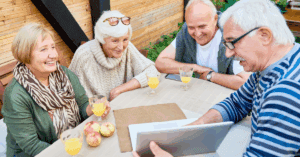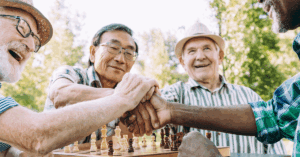
Community goes far beyond amenities and activities—it’s what turns a place to live into a place to belong. As a premier senior living community in Brookfield, WI, Heritage Elm Grove understands this deeply, creating spaces where genuine connections happen naturally, woven into the fabric of everyday life.
At Heritage Elm Grove, mornings begin with conversation and friendship, while someone else handles life’s daily chores. Residents discover their passions don’t fade—they bloom. In this nurturing community, wellness flourishes across all dimensions as neighbors connect, grow and share wisdom in a place that truly feels like home.
How Brookfield Senior Communities Foster Connection
Social bonds don’t just happen on their own. Brookfield’s senior communities understand this truth and intentionally create environments where meaningful connections can take root and grow among residents.
Dining & Activity Areas
- Shared meals create the heart of social wellness, with residents reporting greater happiness.
- Flexible seating arrangements allow friendships to develop naturally
- Variety of spaces beyond dining rooms—lounges, libraries, gardens—encourage casual interactions
Interest-Based Communities
- Clubs and activities connect residents with similar passions
- Resident-led programs create renewed purpose and belonging
- Opportunities range from card games to art workshops to fitness classes
Newcomer Welcome Experience
- Ambassador programs pair new residents with established friends
- Low-pressure welcome events ease transition anxiety
- Thoughtful introductions foster an immediate sense of belonging
Pet-Friendly Environment
- Pets significantly reduce feelings of loneliness among seniors
- Daily pet routines create natural conversation opportunities
- Animal companions serve as social bridges between neighbors
Addressing Loneliness: Practical Steps for Seniors and Families
Loneliness affects more than just your mood—it poses real health risks that demand attention. Social isolation increases the chances of premature death, dementia and heart disease at rates similar to smoking 15 cigarettes daily. The good news? You can take meaningful steps to address this challenge.
Spotting the warning signs early
Recognizing isolation before it deepens makes intervention more effective. Watch for these concerning changes:
- Eating pattern shifts: Missing meals or losing appetite
- Lost enthusiasm for once-loved activities
- Feeling overwhelmed by simple daily tasks
- Communication struggles or concentration difficulties
- Unexplained physical issues like persistent fatigue or headaches
These signs often develop slowly, which makes them easy to overlook without intentional attention to social well-being.
Staying connected with family
Family connections serve as powerful antidotes to isolation. When distance allows, set up regular visit schedules and establish consistent rituals like Sunday phone calls that create anticipation and structure. Sharing this responsibility among multiple family members prevents any one person from feeling overwhelmed while ensuring your loved one receives a steady connection.
Building your social wellness plan
Personal approaches to social connection work best. Consider these elements:
- Plan at least one social interaction each day
- Join community groups that match your interests
- Explore volunteer work, which offers both purpose and companionship
- Talk with people who share similar life experiences through support groups
The path to social wellness doesn’t end with age—it simply takes on new forms. Finding a community that truly cares about meaningful relationships can turn senior living from simply comfortable into genuinely joyful. Your loved one deserves a place where friendships grow naturally and happiness becomes part of everyday life.
Seeing Social Wellness: What a Healthy Network Looks Like
Understanding social connections becomes clearer when we can actually see them. These visual tools help families and caregivers recognize the beautiful web of relationships that support our loved ones’ well-being.
Social Network Map
This family tree-like visualization shows a senior’s relationships with family, friends and community. It helps identify strong connections and areas needing additional support.
Well-being Comparison Chart
This visual shows that seniors with social connections experience better mental health. It demonstrates how social, physical, cognitive and spiritual health combine to create complete wellness.
Community Space Layout
This design shows how thoughtfully planned environments encourage interaction. It highlights Brookfield’s approach to creating spaces that balance social engagement with opportunities for quiet reflection.
Your role as a family member matters deeply in this picture. Those regular phone calls, weekend visits and video chats provide the emotional foundation your loved one needs. Watching for early signs of loneliness helps you step in before small concerns become bigger problems.
Creating strong social connections takes patience and effort, but the rewards are worth it. Seniors who stay active in their communities, explore their interests and keep close family ties tend to feel most at home. Contact Heritage Elm Grove at (262) 786-5800 to discover how our community nurtures social wellness through carefully planned spaces and programs.
FAQs
Q1. What are the benefits of social connections for seniors? Strong social connections in seniors lead to better health outcomes, including reduced depression, improved cognitive function and even longer lifespans. Seniors with robust social networks often report higher levels of overall well-being and life satisfaction.
Q2. How can families help combat loneliness in senior loved ones? Families can combat loneliness by maintaining regular involvement through scheduled visits, consistent phone or video calls and creating meaningful rituals like weekly check-ins. Digital tools for communication and helping seniors create a personal social plan are also effective strategies.
Q3. What role does community design play in fostering social connections? Community design plays a crucial role in fostering connections. Thoughtfully designed common spaces, such as dining rooms, libraries and outdoor areas, create natural gathering points where relationships can develop organically. These intentional design elements directly impact residents’ mental and emotional health.


